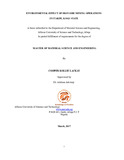| dc.description.abstract | Topsoil stripping, drilling and blasting extraction, waste rock dumping, loading, and unloading, crushing and screening, and materials transport are among other activities involved in iron ore mining. These activities produce fugitive dust that may contain heavy metals which deteriorate the
quality of ambient air. They also cause noise and surface water pollution, not to mention their effects on the soil and vegetation. Corrosion is another issue observed in iron ore mining; corroded iron ore and pipes at mining sites affect the environment particularly ground water quality. Therefore, there is
a need to take mitigating measures.
Heavy metals are bio-accumulated and biotransferred both by natural and anthropogenic sources. The contamination by heavy metals in water, soil, and plants is one of the major issues to be faced throughout the world and requires attention because heavy metals above their normal ranges are extremely threatening to both plant and animal life. It was therefore of interest to conduct a study to estimate levels of heavy metals in water, plants, and soil in Itakpe area, Kogi State. The location (geographical coordinate) of mines, soil, water and plants samples from Kogi State were determined using geological and topographical maps, satellite images and Global Position System (GPS). Field observations, testing of water, soil, and interviews were conducted to determine the effect of mining activities in and around Itakpe in Kogi State. The data obtained was analyzed in order to assess the presence of deleterious elements from mining activities.
Water samples were collected at random from the tailing disposal unit and the water stream around beneficiation plant at Itakpe Iron mining site and nearby village i.e. Abobo village. About seven (7) soil samples, five (5) water samples and three (3) plants namely Cynodon dactylon, Plectranthus
Scutellarioides, and Muhlenbergia rigens were collected from the same region. Heavy metals for which these samples were analyzed were cadmium, lead, chromium, manganese, copper, cobalt, zinc, | en_US |

